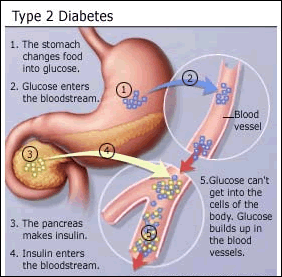HIV
Infection Itself Does Not Affect the Risk of Developing Diabetes, but HIV-HCV
Coinfection Plays a Role
 | HIV
infection itself does not increase the risk of developing diabetes, but increasing
age, hepatitis C virus (HCV) coinfection, higher body mass index (BMI), and certain
antiretroviral drugs are significant risk factors for diabetes in people with
HIV, according to a study published in the June
19, 2009 issue of the journal AIDS. |
 Research
looking at the influence of HIV infection and
its treatment on the risk of developing type
2 diabetes mellitus have yielded differing results. In the present study,
investigators with the U.S. Veterans Affairs (VA) Veterans Aging Cohort Study
determined the predictors of diabetes in 3227 HIV positive and 3240 HIV negative
individuals. Research
looking at the influence of HIV infection and
its treatment on the risk of developing type
2 diabetes mellitus have yielded differing results. In the present study,
investigators with the U.S. Veterans Affairs (VA) Veterans Aging Cohort Study
determined the predictors of diabetes in 3227 HIV positive and 3240 HIV negative
individuals.
In
the HIV positive group, patients were younger on average, were more likely to
be men and to be black, had twice the rate of HIV-HCV
coinfection (31% vs 15%), had a lower BMI, and had a significantly lower prevalence
of diabetes at the start of the study (15% vs 21%). Results
 After adjusting for known risk factors, HIV positive
individuals had a lower risk of diabetes than HIV negative participants.
After adjusting for known risk factors, HIV positive
individuals had a lower risk of diabetes than HIV negative participants.
 The following factors were significantly associated with an increased risk of
diabetes in the HIV positive veterans, and more so than in the HIV negative participants:
The following factors were significantly associated with an increased risk of
diabetes in the HIV positive veterans, and more so than in the HIV negative participants:
 Increasing age
Increasing age
 Male sex;
Male sex;
 "Minority" (non-white) race;
"Minority" (non-white) race;
 Increasing BMI.
Increasing BMI.
 Coinfection with HCV was also a risk factor for
diabetes in the HIV positive, but not the HIV negative, group.
Coinfection with HCV was also a risk factor for
diabetes in the HIV positive, but not the HIV negative, group.
 Use of nucleoside reverse transcriptase inhibitor (NRTI)
and non-nucleoside reverse transcriptase inhibitor (NNRTI)
antiretroviral drugs also were associated with a higher risk of diabetes in the
HIV positive group.
Use of nucleoside reverse transcriptase inhibitor (NRTI)
and non-nucleoside reverse transcriptase inhibitor (NNRTI)
antiretroviral drugs also were associated with a higher risk of diabetes in the
HIV positive group.
Based
on these results, the study authors wrote, "Although HIV infection itself
is not associated with increased risk of diabetes, increasing age, HCV coinfection,
and BMI have a more profound effect upon the risk of diabetes among HIV-infected
persons." "Further,
long-term antiretroviral treatment also increases risk," they added. "Future
studies will need to determine whether the incidence of diabetes mellit us differs
by HIV status."
In their discussion, the researchers suggested that
the lower rate of diabetes among untreated HIV positive people is primarily attributable
to lower BMI.
"We believe that the net risk of diabetes mellitus is
determined by a complex interplay of individual factors, with the traditional
risk factors dominating the profile leading to an overall lower risk in HIV-infected
persons," they wrote.
University of Pittsburgh School of Medicine,
VA Pittsburgh Healthcare System, Pittsburgh, PA. Baylor College of Medicine and
Michael E. DeBakey VA Medical Center, Houston, TX; Rutgers University, New Brunswick,
NJ; New York VA Medical Center, New York, NY; VA Greater Los Angeles Healthcare
System and the David Geffen School of Medicine at UCLA, Los Angeles, CA; VA Connecticut
Healthcare System, West Haven, West Haven, CT; Yale University School of Medicine
and Public Health, New Haven; CT. 7/07/09 Reference
AA
Butt, K McGinnis, MC Rodriguez-Barradas, and others (for the Veterans Aging Cohort
Study). HIV infection and the risk of diabetes mellitus. AIDS 23(10): 1227-1234.
June 19, 2009.
|